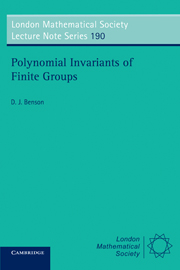Book contents
- Frontmatter
- Contents
- Introduction
- 1 Finite Generation of Invariants
- 2 Poincaré series
- 3 Divisor Classes, Ramification and Hyperplanes
- 4 Homological Properties of Invariants
- 5 Polynomial tensor exterior algebras
- 6 Polynomial rings and regular local rings
- 7 Groups Generated by Pseudoreflections
- 8 Modular invariants
- A Examples over the complex numbers
- B Examples over finite fields
- Bibliography
- Index
3 - Divisor Classes, Ramification and Hyperplanes
Published online by Cambridge University Press: 01 June 2011
- Frontmatter
- Contents
- Introduction
- 1 Finite Generation of Invariants
- 2 Poincaré series
- 3 Divisor Classes, Ramification and Hyperplanes
- 4 Homological Properties of Invariants
- 5 Polynomial tensor exterior algebras
- 6 Polynomial rings and regular local rings
- 7 Groups Generated by Pseudoreflections
- 8 Modular invariants
- A Examples over the complex numbers
- B Examples over finite fields
- Bibliography
- Index
Summary
In this chapter, we calculate the divisor class group Cl(K[V]G). The approach uses Samuel's theory of Galois descent [86]. The final theorem, proved in Section 3.9, states that Cl(K[V]G) is isomorphic to the subgroup of Hom(G,K×) consisting of those homomorphisms which take the value one on every pseudoreflection. As a consequence, we prove a theorem of Nakajima, which states that K[V]G is a unique factorization domain if and only if this subgroup of Hom(G,K×) is trivial. In contrast, the Picard group Pic(K[V]G) is always trivial. We prove this theorem of Kang in Section 3.6.
We also give a ramification formula for the invariant ψ introduced in Section 2.4, and use this to prove the Carlisle–Kropholler conjecture in Section 3.13.
We begin with some generalities on divisors. Our treatment follows Samuel [86], with the exception that there are some minor simplifications arising from the fact that we are not interested in non-Noetherian rings here.
Divisors
We say that a ring A is a normal domain if it is a commutative Noetherian integrally closed domain (these hypotheses are satisfied by K[V] and K[V]G by Proposition 1.1.1 and Theorem 1.3.1). Let A be a normal domain, and let L be the field of fractions of A. A fractional ideal a of A is a non-zero A-submodule of L with the property that there exists a non-zero element x ∈ A with xa ⊆ A.
- Type
- Chapter
- Information
- Polynomial Invariants of Finite Groups , pp. 25 - 44Publisher: Cambridge University PressPrint publication year: 1993

